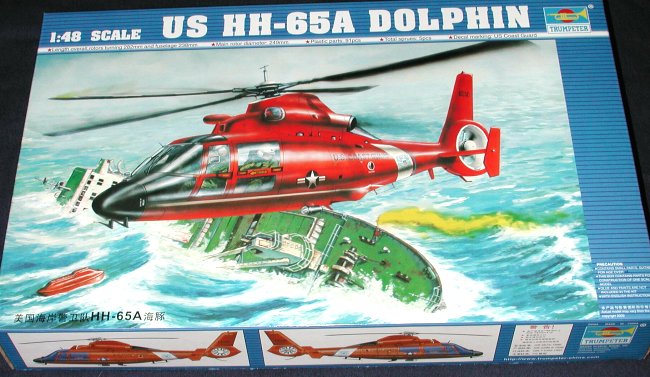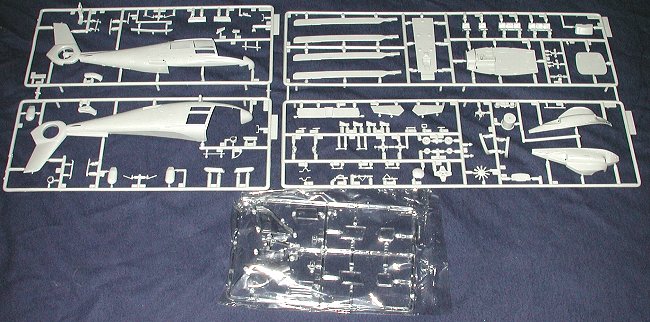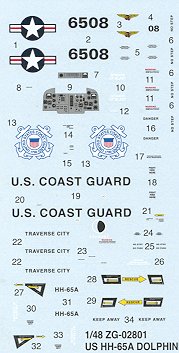
|
KIT: |
Trumpeter 1/48 HH-65A Dolphin |
|
KIT # |
02801 |
|
PRICE: |
$22.95 |
|
DECALS: |
One aircraft |
|
REVIEWER: |
|
|
NOTES: |

|
HISTORY |
My knowledge of the HH-65A is actually quite limited, beyond knowing that it replaced the HH-3 as the standard Coast Guard helicopter. Though this version is unable to alight on the water as the H-3 was able to, it has improved performance thanks to its twin engines. It is also faster than the H-3, a consideration that was undoubtedly made when choosing this French-designed helo. According to the box end, the HH-65 is made in Texas.
The HH-65 is a derivative of the AS.365 Dauphin that has been operated by countries around the world. It is a rather hi-tech helo compared to what came before it and it seems as if it has been a good choice. This helo has also been license built in the PRC and sees wide use not only with their coast guard, but also as the standard warship-based helo.
|
THE KIT |

It is undoubtedly the Chinese connection that has allowed this kit to see the light of day. I'm not really sure just what the market is for plastic kits in the PRC, but it is obviously enough to warrant the production of this kit. The other boxing I have seen contains a Chinese and Icelandic version, which appears to be little more than different decals.
I'd heard this kit was on its way, so when I saw it at the local hobby shop, I chose the USCG version as it seemed it would be a more colorful version and easier to paint! Unlike the HH-3s that it replaced, the HH-65s are all painted in the Arctic scheme of International Orange with a white fuselage band. Until this kit arrived, the only Dauphin available was the Matchbox 1/72 kit. Unfortunately, it was quite different from the HH-65 and could not be made into the USCG variant.
The kit itself comes on three large sprues, the clear one being much bigger than one would normally find on a fixed wing aircraft of this size. Detailing is fairly good. I found some areas where the engraved panel lines sort of disappeared and then came back again. There are also ejector pin marks all over the place. While none are particularly difficult to remove, they are there and will have to be filled. The most visible will be those on the inside of the gear doors and the underside of the blades. The blades themselves are not very convincing, being rather flat with no airfoil shape. The leading and trailing edges are actually square cornered so some shaping will have to be done with them. There is also a teeny bit of flash on a part or two and there are some sink areas on some of the thicker parts.
 As you probably know, I'm
dimensionally challenged (I don't measure kits against plans) so you'll have to
rely on others to let you know what is really wrong with the kit in that area.
To me, it looks very much as it should.
As you probably know, I'm
dimensionally challenged (I don't measure kits against plans) so you'll have to
rely on others to let you know what is really wrong with the kit in that area.
To me, it looks very much as it should.
The instruction sheet is fairly good and appears to give colors in Gunze codes. The construction sequence is well thought out as well. Helo fans will be pleased to know that the kit includes both a cyclic and collective as well as separate rudder pedals for the cockpit. In fact, the cockpit and cabin look fairly well appointed. You get two rows of seats for the cabin area, but I'm not sure that a USCG version would have more than one set of seats, and probably only the aft set. The instrument panel and center console are devoid of detail, with a decal for the instrument panel only. There is no mention of nose weight, but I'd think some would be needed to prevent tail sitting. Finding a spot for it will be a challenge.
There are decals for just the box art aircraft, which is from Traverse City, Michigan. It is in the standard Arctic scheme for USCG HH-65s and is given in the color chart as Gunze Red Madder and Gunze White. I think I'd go for a reddish International Orange, myself. Perhaps a reader can supply an appropriate FS number. The decals are quite well printed and very crisply done. I don't know how well they work as I've never built a Trumpeter kit, but the sheet is rather complete as you can see.
|
CONCLUSIONS |
I know that helo fans will flock to this one. Despite the glitches mentioned, there is little that cannot be fixed with a bit of extra work. It is a subject that I never thought I'd see in a mainstream injected kit and one that appears to be well engineered. Only the addition of glue will tell for sure!
Reader Pascal send in this info on the kit.
I guess the guys at Trumpeter took dimensions of the Chinese licensed built copy of the original Dauphin and marketed it at the USCG HH-65 version but there are 2 main differences :
1- The USCG replaced the original Turbomeca Arriel power plant by the more powerful Lycoming turbines. Thus, the fairing is very different, with a more bulbous shape, lower profile. Parts B 2 & B 3 (Upper fuselage assembly) are totally wrong for the HH-65. You need to reshape them with plasticard and putty. A though task.
2- To compensate for the extra power, the FENESTRON was enlarged by almost 20 %. It is very noticeable. Another difficult plastic surgery task to achieve a realistic result.
As you already mentioned it, the cabin/cargo configuration has nothing to do with the original. You are in for a lot of work to modify the ceiling, walls and scratchbuild an accurate interior.
Conclusion : if you want a civilian Eurocopter SA-365 Dauphin, the kit is 95 % correct. You only need to scratchbuild some details in the cabin. If you are expecting an OOTB HH-65A Dolphin, you are heading for a big disappointment.
Martin ? sends in this information on the HH-65:
The Aerospatiale HH-65A Dolphin replaced the Sikorsky HH-52A Seaguard in the Coast Guard.
The Sikorsky HH-60J Jayhawk replaced the Sikorsky HH-3F Pelican.
Both the 52 & 65 are considered Short Range Recovery (SRR) helos and the H-3 & 60J are Medium Range recovery (MRR) helos.
The 52 was the first helo designed to land in the water back in the ‘50s. It was also single engined. The H3 was also designed to land in the water and it was twin engined. Both the 65 & 60 are twin engined but can only land in the water once… LOL
The 65s weren’t always painted International Orange, but had a paint scheme similar to all the Coast Guard helos before it. Sometime around the mid 80s, the CG decided to start painting all the 65s in orange as a money saving device. Up until then, only the helos based at the CG Air Station in Mobile, Al were painted in orange and the rest in the CG were white with the CG racing stripe. The Mobile helos were the ones used for Artic patrols, hence the higher visibility orange paint scheme. What the Cg was doing when ever a helo rolled out from overhaul in North Carolina was having to decide which airframe would be stationed where in the country and because of that decision, what color to paint it. Some white, some orange. Now they don’t worry about that portion because they’re all orange.
Review kit courtesy of my kit collection.
If you would like your product reviewed fairly and fairly quickly by a site that has well over 100,000 visitors a month, please contact me or see other details in the Note to Contributors.